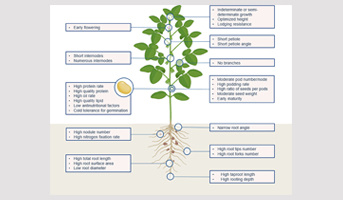Genome editing, an opportunity to revive soybean cultivation in Europe
A review by the DRAGON team published in The Plant Journal, February 2025
Soybean (Glycine max Merr.) is the world's most important oilseed crop and its ability to fix atmospheric nitrogen makes it a cornerstone of sustainable agriculture. Despite its importance, Europe relies heavily on imports, leading to environmental and economic vulnerabilities. To address these challenges, the European Union has implemented policies to boost local soybean production, emphasizing sustainable practices and reduced dependency on imports. However, conventional breeding methods are time-consuming and may not keep pace with the rapid environmental and consumer habit changes. Genome-editing technologies, such as CRISPR-Cas, offer precise and efficient tools for developing soybean varieties tailored to European conditions. These technologies can enhance traits related to precocity, stress responses, yield and quality that are essential for adapting to climate change and promoting ecological sustainability. This review explores the integration of genome editing (GE) in soybean breeding, highlighting its potential in advancing the agroecological transition in Europe. By having a clear regulation and enhancing breeding efforts, GE can significantly contribute to developing resilient and sustainable soybean varieties, fostering a competitive and environmentally friendly European agriculture.
In connection with the research developed at the Institute Jean-Pierre Bourgin for Plant Sciences.
In connection with the research developed at the Institute Jean-Pierre Bourgin for Plant Sciences.
Back

Légend: Example of traits that could be targeted for soybean breeding in Europe.
IJPB Highlight
Reference :
Monfort M, Buitink J, Roeber F, Nogué F.Genome editing, an opportunity to revive soybean cultivation in Europe. The Plant Journal 2025
doi : https://doi.org/10.1111/tpj.17266
Contact:
Fabien Nogué, contact
IJPB team:
"DNA Repair and Genome Engineering" DRAGON team